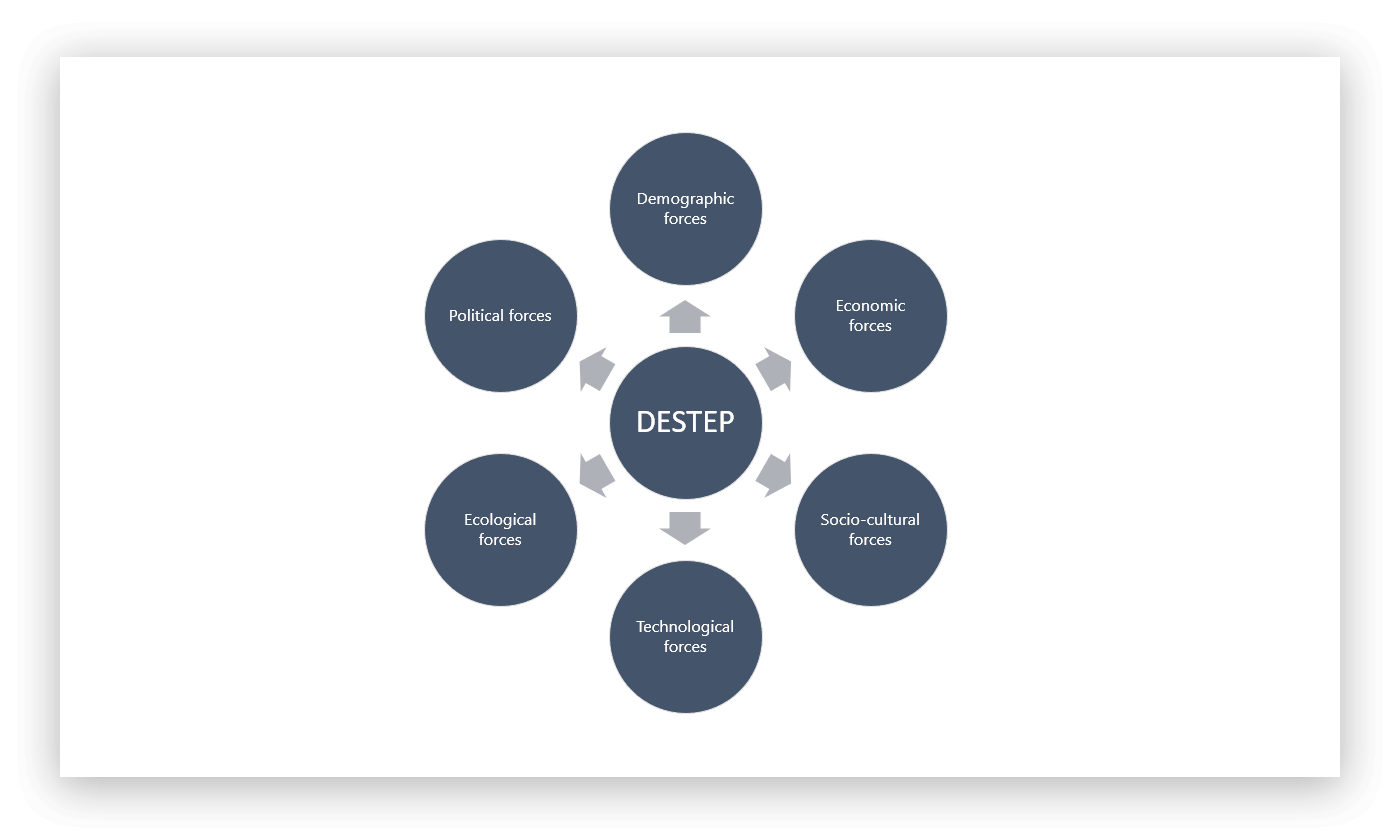DESTEP Analysis Model of External Environment
What is DESTEP Analysis?
A DESTEP Analysis is a model used to analyze the business’s external environment and the issues that are likely to impact the organizations. DESTEP is an acronym that stands for Demographic, Economic, Sociocultural, Technological, Ecological, and Political/Legal.
These are the six external factors that are used to understand the likely impact on the business to create an action plan to address any potential risks before they become problems.
Creating a DESTEP analysis model helps any manager clarify how a company can best deal with Macroeconomic factors and adjust the business strategy accordingly.
DESTEP Analysis Model

DESTEP Demographic Analysis
Demographics are vast and ever-changing. But the information is vital to understanding the state of society, as it dictates what affordable items you can buy at your favorite retailer. The demographics are an integral part of doing business and should be considered when crafting a strategy for success.
Only by knowing how much people consume can companies make appropriate decisions about production levels or even create new products that can sell well in a certain region. Demographics provide a rough idea about population growth or decrement and should be used accordingly, so businesses don’t fall flat on their faces due to a lack of know-how about their customer base!
When discussing demographics factors where you can look into DESTEP analysis model include:
- The shifts in geographic spread
- Age structure
- Gender
- Diversity
- Level of education/profession
- Consumer income
- Family size
- Urbanization degree
- Migration patterns
DESTEP Economic Analysis
With economic forces in DESTEP analysis, it analysis the state of the economy of the country or area of doing business. The key thing here is looking at the current state of the economy and possible threats and opportunities.
As a company, you should never start exporting to a country before carefully examining how much people will spend. Important criteria are GDP, which measures the size of an economy; GDP real growth rate, which estimates future income and spending ability; GNI, or Gross National Income; Import Duty rates and sales tax/ VAT (Value Added Tax), which control what consumers can purchase inside their borders; Unemployment levels as well as Inflation rates that measure consumer purchasing power due to inflation-adjusted wages. As the preceding points illustrate, it is important for companies who want to sell products abroad to consider these economic factors when deciding where they would like to do business.
Some common economic factors where you can look into DESTEP analysis include:
- Inflation and deflation
- interest rate
- Employment opportunities
- Unemployment rate
- Distribution of national income
- Availability of energy
- Energy costs
- Biggest sectors
- Import/export ratio
DESTEP Social-Cultural Analysis
As a business, it’s important to pay attention to the “voice” of your customers. This means you need to understand the latest trends in customer requirements and current market demand. Analyzing these various factors will help you make more informed decisions for your company.
💥🎁 New Year & Easter Deals On Amazon !
Don't miss out on the best discounts and top-rated products available right now!
🛒 Shop Now and Save Big Today!*As an Amazon Associate, I earn from qualifying purchases.
Socio-cultural factors where you can look into DESTEP analysis include:
- Values and standards that apply
- Average level of education
- Religious beliefs
- Subcultures
- Chauvinistic feelings
DESTEP Technological Factors Analysis
Technological factors include technological aspects like Research &Development activity, automation, technology incentives, and the rate of technological change. These factors can determine barriers to entry, minimum efficient production level and influence the outsourcing decisions. Furthermore, technological shifts would affect costs, quality and lead to innovation.
Technological factors where you can look into DESTEP analysis include:
- New products, software’s, plug-ins, and apps
- Discoveries and developments
- Life cycle of existing and aging technology
- Improved existing products, software, plug-ins, and apps.
- Design of new and improved products
- Better service methods
- More efficient distribution systems
- Complete new markets
- New social media platforms
- Changes within the algorithms of existing social media
- Changes in how to advertise and communicate in both offline and online media.
Ecological Factors Analysis
Ecological factors include everything in the environment. It’s a key topic in recent years, including areas around climate change, carbon footprint, recycling, and waste management. Other ecological variables comprise sustainability, safety, energy, garbage, and climate.
DESTEP Political /Legal Factors Analysis
Certain political and legal restrictions come in the way of business developments, such as setting maximum & minimum prices, political measures, and zoning.
To overcome all these factors, certain points that need to be kept in consideration include licenses, funds, and legislation.
To avoid future problems, companies must keep up with all the changes in the law. But that is hard when there are so many restrictions coming from government regulations and policies. This means firms have to work around a lot of rules and regulations.
Political/legal factors where you can look into DESTEP analysis include:
- Political stability
- Believes and standpoints of politicians and parties.
- Levels of politics (local, regional, state, national)
- Tax policy and loopholes
- Workers/market legislation
You can also look at what the law says about specific rules on:
- Law and Deontological code around advertisement
- Product safety
- Packaging
- Labels
- Transport
- Relationship and communication with customers and international trades.